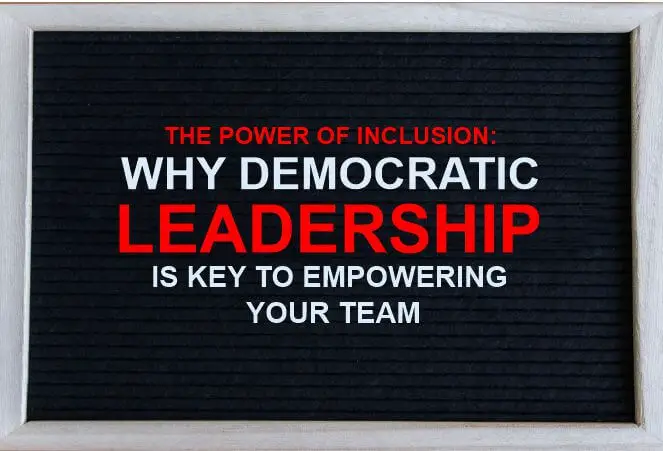Last updated on January 10th, 2024 at 11:42 pm
In relying on team participation and the input of others in discussions and decision-making, democratic leadership enjoys the admiration of many because of its openness.
There are several types of leadership styles, and each is characterized by unique features and approaches.
Every leader aims to get results and achieve the desired set goals. Each leadership style is driven by many factors which include personality, organizational culture, experience, subordinates, and situations.
In this blog post, we will explore the concept of democratic leadership, its benefits, and how to implement it in your organization. See the other leadership styles.
What is the Democratic Leadership Style?

Democratic leadership style also called participatory leadership is a management style that emphasizes collaboration, inclusivity, and consensus-building.
The highlight of this type of leadership is the inclusiveness of team members in the decision-making process and giving them room to exercise their creativity and grow.
In this approach, the leader acts as a facilitator, encouraging input from team members and fostering a collaborative environment.
The idea behind the democratic leadership style is that when team members are involved in decision-making, they are more invested in the outcome and are more likely to be motivated to achieve the organization’s goals.
Related: How to Lead in Your Relationship
How does Democratic Leadership Work?
The Democratic Leadership approach involves gathering input from subordinates and team members so everyone has a chance to contribute to the decision-making process.
Leaders who practice democracy still make the decisions but they allow their subordinates to participate and have a stake in the result.
Democratic leaders are emotionally smart and do well at honing creativity among subordinates while speeding up projects when everybody contributes.
In a democratic leadership style, the leader empowers employees or members to contribute their ideas, skills, and expertise to the decision process.
The leader encourages communication channels and values diverse opinions, which fosters creativity, and new ways of thinking.
Related: Loosening The Reins: A Deep Dive Into Laissez-Faire Leadership Style
The involvement of multiple perspectives and ideas helps minimize conflict and promote of decision and individual commitment to achieving the team’s goals.
In this type of leadership, leaders show some traits of transformative leadership style which stimulates the growth of individuals and grooms new leaders among the members.
They understand that the key to success is to cultivate a culture of leadership within the organization, giving the team opportunities to learn new skills and take on new challenges.
Democratic leaders improve the engagement and curiosity of employees when they are allowed to make suggestions in decision-making.
Workers under a democratic leadership style are happy people because they are given the opportunity to be creative. They feel valued and respected and of course, this is a boost to the organization.
Examples of Democratic Leadership

Brainstorming sessions: Regular brainstorming is characteristic of participatory leadership to bring forth ideas from employees. This inclusiveness opens the creative paths of the workers.
Group decision-making: A leader who is democratic may involve team members in the decision-making process by gathering input and feedback from everyone.
This approach ensures that everyone’s voices are heard, and team members feel valued and invested in the decision.
Collaborative problem-solving: When faced with a problem or challenge, the leader may encourage team members to work together to find a solution.
This approach leverages the strengths and expertise of each team member, leading to better and more sustainable solutions.
Open-door policy: A democratic leader may have an open-door policy that encourages team members to share their ideas and concerns. This approach promotes transparency, communication, and trust within the team.
Feedback and evaluation: He may seek feedback and input from team members on their performance, strengths, and weaknesses. This approach promotes self-consciousness, personal growth, and development for all team members.
Qualities of Democratic Leaders
Leaders who are democratic have the drive for input from every side available. Their intuition helps them see the potential in employees and pushes them further to elicit this creativity.
Their interest in an enabling environment makes them good subordinates and communicators and this makes them approachable.
Here are some of the prominent qualities of the democratic leadership style:
Encourages participation: Participatory leadership encourages team members to participate in decision-making processes and creates a sense of inclusiveness among the subordinates.
Effective communication: It stresses effective communication among team members, which helps to avoid misunderstandings, promotes collaboration and promotes transparency.
Inclusivity: It values inclusivity and encourages diversity in opinions, ideas, and backgrounds. This promotes innovation and creativity.
Flexibility: Democratic leaders are flexible and embrace change. They are open to feedback and suggestions from team members to make necessary adjustments.
Related: Autocratic Leadership Style: Pros And Cons, Examples And Characteristics
Empathy: Participatory leaders are empathetic towards team members’ needs, and they value their opinions. This helps to build trust and foster teamwork.
Accountability: They hold themselves accountable for their actions and decisions. Also, the decisions and actions of the team members are responsible for how they are treated.
Encourages growth: It promotes personal and professional growth among team members. They provide opportunities to learn, train, and develop skills.
Focus on results: It values results and outcomes. They set clear expectations and goals for team members and work towards achieving them collaboratively.
Pros and cons of Democratic Leadership
Benefits of democratic leadership
There are several benefits to using a democratic leadership style in your organization, including:
Improved decision-making: When team members are involved in decision-making, they bring a diversity of perspectives and ideas to the table, resulting in better decision-making.
Increased motivation and engagement: When team members feel that their opinions are valued, they are more likely to be motivated and engaged in their work.
Better communication: Democratic leadership encourages open communication and collaboration, which can lead to better relationships between team members.
Higher job satisfaction: When team members are involved in decision-making, they are more likely to feel a sense of ownership over their work and be satisfied with their job.
Improved collaboration and communication: By involving team members in decision-making processes, democratic leadership can help foster a more collaborative and communicative culture within your organization.
Related: The Power Of Transformational Leadership
Better problem-solving: When a team taps into the collective brainpower of its members, it can often come up with more creative and effective solutions than when a single person makes a decision in isolation.
Increased employee engagement and job satisfaction: When employees feel like their opinions matter and that they have a say in decisions, they tend to be more engaged and satisfied in their jobs.
More diverse perspectives: By encouraging participation from everyone, democratic leadership can help ensure that all voices, including those from underrepresented groups, are heard and considered.
Higher quality decisions: By involving more people in the decision-making process, you may be able to achieve better outcomes that are informed by a broader range of perspectives and expertise.
Challenges of democratic leadership
However, it’s important to note that democratic leadership comes with some potential drawbacks.
Since style is based on building consensus, it can be time-consuming, leading to delays in making decisions.
Also, building consensus can be challenging when working with diverse groups, especially when dealing with people that have strong emotions or biases.
Overall, it is a powerful leadership style that emphasizes collaboration, mutual respect, and active participation in decision-making, leading to positive outcomes for both the team and the organization.
How to Implement Democratic Leadership in Your Organization
Implementing this style of leadership in your organization requires a few key steps:
Communicate the vision and goals: To implement this leadership, you must communicate the organization’s vision and goals to your team members.
This will help them understand the direction of the organization and how their input can contribute to achieving those goals.
Foster open communication: Encourage open communication among team members by creating a culture of transparency and inclusivity.
This can be done by creating channels for feedback and suggestions, conducting regular team meetings, and encouraging open dialogue.
Related: Quiet Leadership: The Power Of Being A Silent Leader
Encourage participation: Actively seek out input and participation from team members in decision-making processes.
This can be done by soliciting feedback, conducting brainstorming sessions, and involving team members in project planning.
Empower team members: Give team members the autonomy and resources they need to make decisions and take ownership of their work.
This can be done by delegating tasks and responsibilities, providing training and development opportunities, and giving team members the tools, they need to succeed.
Conclusion
By involving team members in decision-making processes, organizations can improve decision-making, increase motivation and engagement, and foster better communication and relationships among team members.
Implementing participatory leadership requires communication, open dialogue, active participation, and empowerment of team members.
By embracing democratic leadership, organizations can create a more engaged and productive workforce that is invested in achieving the organization’s goals.
Frequently Asked Questions on Democratic Leadership
Here are some frequently asked questions about democratic leadership:
What is democratic leadership?
Democratic leadership, also known as participative leadership, is a style of leadership where the leader involves team members in decision-making and encourages collaboration.
What are the benefits of democratic leadership?
It has many benefits, including increased team engagement and satisfaction, better collaboration, increased creativity and innovation, and higher-quality decision-making.
What are the drawbacks of democratic leadership?
It can be time-consuming and slow, as it involves collecting input and feedback from multiple team members.
It may also lead to indecisiveness if there is a lack of consensus among team members.
When should democratic leadership be used?
It is most effective when team members have expertise in the subject matter or are affected by the decisions being made.
It should also be used when there is a need for collaboration, shared ownership, or accountability of the outcomes.
What are some common examples of democratic leadership?
Common examples of democratic leadership include brainstorming sessions, group decision-making, and collaborative problem-solving.
Can democratic leadership work in every situation?
While democratic leadership can be effective in many situations, it may not be ideal for situations that require quick decisions or where the leader has specific expertise that team members do not have.
Can a leader switch between different leadership styles, including democratic leadership?
Yes, a leader can use a variety of leadership styles depending on the situation and the needs of the team. Effective leaders are often able to adapt their approach to fit the situation.
Thank you for reading.
References
What Is Democratic Leadership?
Leadership Styles, Pros And Cons, How To Make It Work
What You Need To Know About Democratic LeadershipKey Characteristics Of Democratic Leadership
Pious Clements is the insightful voice behind "The Conducts of Life" blog, where he writes about life ethics, self-development, life mastery, and the dynamics of people and society.
With a profound understanding of human behaviuor and societal dynamics, Pious offers thought-provoking perspectives on ethical living and personal growth.
Through engaging narratives and astute observations, he inspires readers to navigate life's complexities with wisdom and integrity, encouraging a deeper understanding of the human experience and our place within society.



